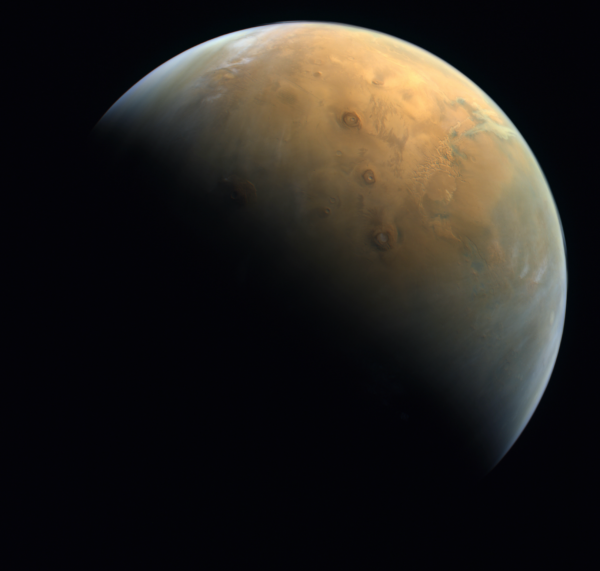FOR MORE INFORMATION, CONTACT:
Heather Reed, LASP EMM media coordinator
Heather.Reed@lasp.colorado.edu

Image Credit: MBRSC/UAE Space Agency/CU-LASP/EMM-EXI
Key Takeaways:
- The Emirates Mars Mission successfully entered orbit around Mars on February 9, 2021.
- The first science image of the Martian planet was taken by the Emirates eXploration Imager (EXI) on February 10, 2021, one day after orbit insertion.
- The orbiter, named ‘Hope’ (Al Amal in Arabic), and two of the three science instruments on board, Emirates eXploration Imager (EXI) and Emirates Mars Ultraviolet Spectrometer (EMUS) were developed at LASP in partnership with MBRSC engineers.
- The mission, the first interplanetary exploration undertaken by an Arab nation, will spend one Martian Year (about two Earth years) orbiting around the red planet gathering crucial scientific data on its atmosphere.
The Emirates Mars Mission (EMM), the first interplanetary exploration undertaken by an Arab nation, achieved a major milestone on 9 February 2021 when it entered into orbit around Mars. It will spend one Martian Year (about two Earth years) orbiting the red planet gathering crucial science data.
As the mission moves into its science phase, the Hope Probe achieved another major milestone with the return of its first science image taken by the Emirates eXploration Imager (EXI). The image was taken at an orbit altitude of 24,700 km above the Martian surface at 20:36 UTC on 10 February 2021, one day after arriving at Mars.
The composite color image was created by combining red, green, and blue EXI images. The North pole of Mars is in the upper left of the image. At center, emerging into the early morning sunlight, at the boundary of day and night, is the largest volcano in the solar system, Olympus Mons.
Also prominent are the three large shield volcanoes of Tharsis Montes (Ascraeus Mons, Pavonis Mons, and Arsia Mons). Looking East or to the right of the three volcanoes, is the mighty canyon system of Valles Marineris, filled with clouds, near the limb (or edge of the visible portion of the planet). Clouds can also be seen just above the limb (top of image and middle right, when looking between the planet and space). These clouds, seen in different geographic regions and at different times of day, provide a preview of EMM’s contributions to our understanding of the Martian atmosphere.
This first image is the first of many such views of Mars that will be used to study the planet’s weather and climate systems.
“Look at all the clouds…we were expecting great things from EXI, but seeing the clouds above the limb, and in the craters and valleys took my breath away,” noted Andrew Jones, LASP Instrument Scientist for EXI.
“The EMM data, with its combined diurnal and seasonal coverage, will give us a new look at Martian water ice clouds and their connections to outstanding questions related to weather and climate,” said Mike Wolff, Senior Research Scientist and EXI Instrument Scientist, at Space Sciences Institute.
The mission is being carried out by the Mohammed bin Rashid Space Centre (MBRSC) in the UAE in collaboration with US research institutions, including the Laboratory for Atmospheric and Space Physics (LASP) at the University of Colorado Boulder, Arizona State University, and Space Sciences Lab (SSL) at University of California, Berkeley.
EXI is one of the three science instruments on board the Hope Probe, developed by MBRSC and LASP engineers and scientists. The EXI camera’s high-resolution images will characterize the distribution of water ice, dust, and ozone in the Martian atmosphere. The other two instruments, Mars Ultraviolet Spectrograph (EMUS), also developed at LASP, and the Emirates Mars InfraRed Spectrometer (EMIRS), developed at ASU, will return their first science data as EMM officially starts its science phase in the coming months.



